NIDIS Drought and Wildland Fire Nexus (NDAWN) Strategy
NDAWN is rooted in developing partnerships and collaboration with the wildland fire management community. It was launched to address the challenges fire managers face and to establish a robust drought and wildland fire decision-support information network.
NDAWN: Meeting the Needs of the Fire Management Community
Five federal agencies are responsible for wildland fire management: the U.S. Department of Agriculture's U.S. Forest Service and the Department of the Interior’s Bureau of Indian Affairs, Bureau of Land Management, Fish and Wildlife Service, and National Park Service. Other agencies provide support with interagency coordination through the National Interagency Fire Center (NIFC) Predictive Services, the Geographic Area Coordination Centers, and the National Wildfire Coordinating Group. In addition, a multitude of state agencies, prescribed fire councils/alliances, and local fire departments, along with international coordinating efforts, make up the broader fire management community.
Since 2015, the NIDIS Drought and Wildland Fire Nexus (NDAWN) has convened 8 regional and subregional workshops, presented to fire practitioners at 8 conferences, and interviewed 15 fire weather forecasters on the impacts of drought on wildfire planning, behavior, and post-wildfire response. Fire managers and planners emphasized a need for increased engagement across agencies and the public on the topic of drought and wildfire. Many of the impacts identified are already present in the absence of drought. However, drought amplifies these impacts, and some can transmute into entirely new impacts, both in intensity and consequences.
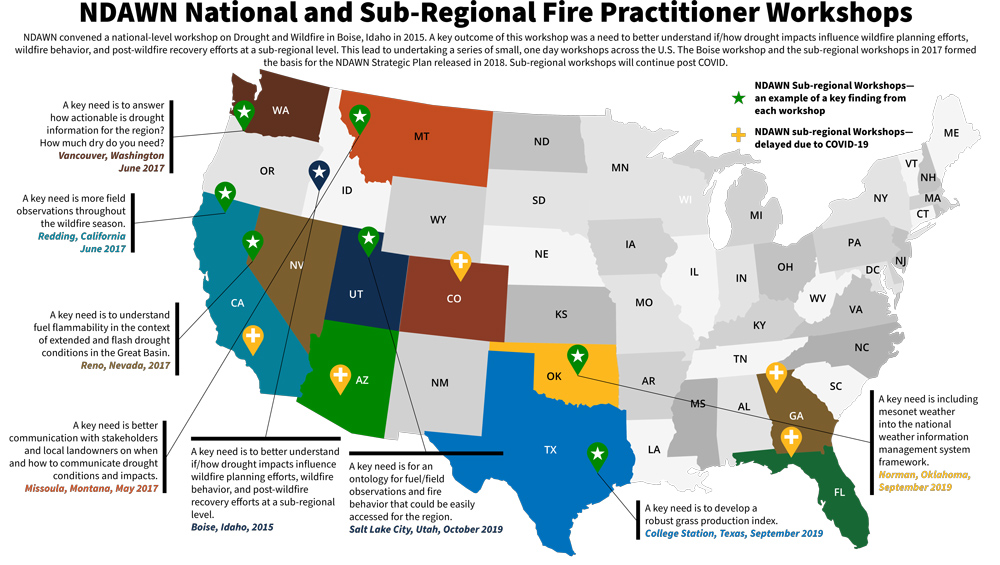
Key Challenges Identified by Wildland Fire Practitioners/Managers:

What Is NDAWN?
The Western Regional Climate Center, Desert Research Institute, and NIDIS partnered to form the NIDIS Drought and Wildland Fire Nexus (NDAWN) to identify priorities and actions to improve products and communication in the drought and fire communities.
NDAWN is both a strategy and a network. As a strategy, it defines the needs and challenges of fire managers to effectively utilize drought information and aims to meet those needs and to establish a robust drought and wildland fire decision-support information network. This strategy presents a logical framework to guide how NIDIS investment over the next five years could benefit both wildland firefighters and public health and safety in fire-prone areas of the United States. NDAWN also functions as a network at multiple scales, from sub-regional to national. This multi-tiered approach of direct engagement enables NIDIS and its partners to better understand drought impacts for on-the-ground fire management and identify how drought impacts could be mitigated.
NDAWN Goals and Research Themes
- To involve the fire community in the Drought Early Warning Systems (DEWS) and drought information networks supported by NIDIS, state, and local agencies to successfully utilize drought information in fire management programs.
- To provide a baseline of how drought information is currently used in the wildfire community and primary sources, establishing a longitudinal survey mechanism to understand drought information use in the fire management community, enabling NIDIS to identify changes in use and priority issues over time.
- To identify gaps and needs related to drought information in the wildfire community.
- To initiate the development of a network that successfully disseminates and utilizes drought information in fire management planning, behavior, and effects decision contexts at state and regional levels.
Promoting meaningful consultation with the wildfire management community, NIDIS will identify gaps in information and work through a co-production model to address those needs.
NIDIS will work with partners to refine and augment existing tools and develop new tools that integrate with existing decision support structures to incorporate drought information into wildfire management.
NIDIS will support applied research to explore how antecedent climate and weather conditions impact the fire season; how drought impacts fire behavior and effects; and how drought impacts post-fire recovery and hazards.
NDAWN, in coordination with NIDIS and other partners, will serve as an established interface between drought and wildland fire stakeholders and help share key messages concerning wildland fire management with the public.
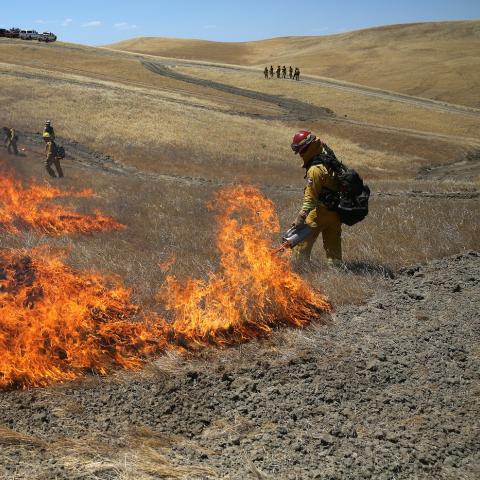
Knowledge Exchange
Working with the wildfire management community to improve our understanding of decision contexts for fire management will help to identify information needs, gaps, and entry points for the use of existing drought information. A co-production model will be utilized to do research that is user- and application-driven to increase engagement between the fire and drought communities.
- Geographic Area Coordination Center (GACC) Stakeholder Meetings
- Forest Service Soil Moisture Monitoring Network Engagement Meetings
Tool Development
As our understanding of the relationship between fire and drought expands, providing information that improves fire management and safety is a priority. While some new tools may be identified as having decision-support value, emphasis should be placed on existing tools that have direct connections to fire and can be utilized directly in decision support systems that are already in use. Immediate needs that are being addressed include the increased usage of sub-seasonal forecasts in operational fire behavior assessments and incorporation of drought into the National Fire Danger Rating System.
- Forecasts of National Fire Danger Rating System Fire Danger Indices
- Organic Soil Moisture Monitoring in Coastal North Carolina: Assisting Coastal Zone Fire Risk Monitoring and Management
- NASA DEVELOP: Utilizing NASA Earth Observations and NOAA Climate Data Records to Produce Climate Indicators of Rangeland Health and Wildfire
- Topofire Soil Moisture Modeling to Support Drought Management and Develop an Updated KBDI for Wildfire Management
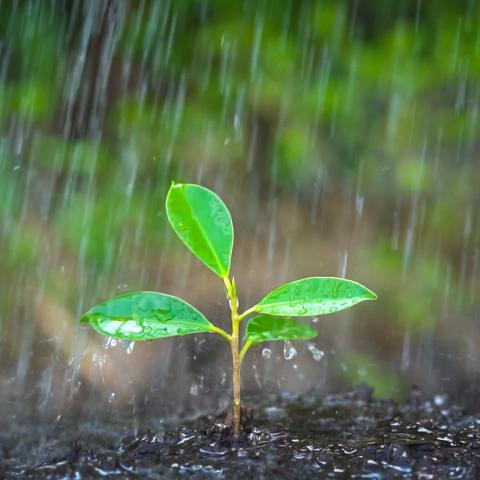
Science & Research: Climate and Antecedent Conditions
Research has shown that drought and wildfire are strongly connected, and drought can be intensified by processes tied to climate change—unusually warm temperatures, changes in precipitation, changes in snowpack and melting. The resulting decreased streamflow, dry soils, and large-scale tree deaths create conditions with increased potential for extreme wildfires that spread rapidly, burn with more severity, and are costly to suppress. NIDIS is supporting efforts to better quantify these processes and understand their contribution to fire danger, so that they can be integrated into decision support tools used by the wildfire management community.
- Establishing Relationships Between Drought Indices and Wildfire Danger Outputs
- Tackling Challenges of a Drier, Hotter, More Fire-Prone Future
- Characterizing Atmosphere, Land Surface, and Fire Interactions to Improve Drought Early Warnings over the Great Plains and California
- Disentangling Complex Interactions Among Droughts, Fires, and Snowpack in the Western U.S.
- The Climate, Weather, and Fire Timeline: To What Extent Is a Fire Season Influenced by a Sequence of Antecedent Conditions to Fire on the Ground? (Coming Soon)
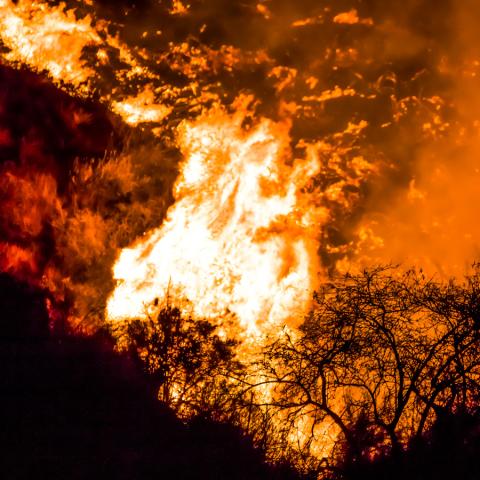
Science & Research: Fuels
During drought conditions, fuels for wildfire, such as grasses and trees, can dry out and become more flammable. Drought can also increase the probability of ignition and the rate at which fire spreads. NIDIS is supporting research to better understand these processes and apply that understanding to increase fire fighter and public safety by ensuring that fire professionals have drought information for fire behavior forecasts and long-term fuel management planning.
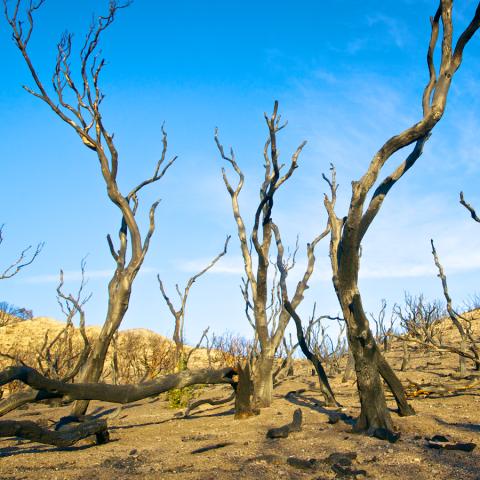
Science & Research: Post-Fire Recovery
After the wildland fires have been extinguished, the threat of post-fire debris flows and shallow landslides may be of concern for years. Drought conditions inhibiting recovery of soils and vegetation contribute to the potential of post-fire debris flows and landslides. Research is needed to understand the extent of the period of time during which downstream communities are vulnerable. Drought may also impact the success of restoration projects. These impacts need to be understood and incorporated into planning to avoid bad investments and adjust techniques and approaches to improve success rates.

Communication
NDAWN, in coordination with NIDIS and other partners, should serve as an established interface between drought and wildland fire stakeholders at multiple scales, from sub-regional to national. Communication is not just within the fire management community. It is also important to use established networks to disseminate information and improve public awareness around issues like prescriptive fire and other fuel treatments, human health impacts of smoke, during drought events, and the contributions of drought to wildfire potential.

